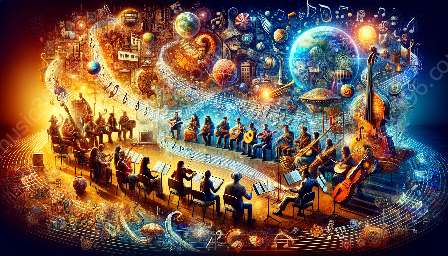Languages and music are two fundamental aspects of human culture, and the intersection of these two realms has yielded a rich tapestry of artistic expression across diverse societies. In cross-cultural music studies, the influence of language on musical styles, themes, and structures, as well as the reciprocal impact of music on language, has been a subject of profound interest and inquiry. By exploring the intricate relationship between language and music, we gain deeper insights into how these two art forms shape and reflect the cultural identities of communities worldwide.
Influence of Language on Musical Expression
One of the most compelling aspects of the intersection of language and music is the profound influence of linguistic elements on musical expression. Through the unique phonetic characteristics, tonal patterns, and rhythmic structures of various languages, musicians are able to infuse their compositions with distinct vocal qualities, melodic contours, and lyrical themes. For example, in traditional Chinese music, the tonal nature of the language has influenced the use of pentatonic scales and specific melodic intervals, creating a close connection between the musical and linguistic tonal systems.
Similarly, in the realm of Western classical music, composers have drawn inspiration from the poetic and phonetic qualities of different languages to shape their compositions. The nuances of vowel sounds, consonant articulation, and rhythmic stress present in languages such as Italian, French, and German have informed the phrasing, articulation, and emotional resonance of vocal and instrumental music. The rich interplay between language and musical expression underscores the deep cultural and emotional significance embedded in the melodies, harmonies, and lyrics of diverse musical traditions.
Role of Music in Shaping Language
Beyond the impact of language on music, the reciprocal relationship between music and language extends to the realm of linguistic development and cultural identity. Across various cross-cultural contexts, music has played a pivotal role in shaping the phonological, lexical, and syntactic elements of language. From lullabies and nursery rhymes that transmit cultural heritage to rhythm and intonation patterns that reflect social dynamics, music has contributed to the evolution and preservation of language within communities.
An illustrative example of this phenomenon is found in the melodic intonation therapy used in the rehabilitation of individuals with aphasia, a language disorder typically caused by brain damage. By leveraging the musical elements of rhythm, pitch, and melody, therapists can aid patients in rebuilding their language skills and re-establishing communication abilities. The success of this therapeutic approach demonstrates the profound impact of music on language and the potential for cross-cultural studies to enhance our understanding of these interconnected domains.
Impact on Music and Culture
The intersection of language and music exerts a significant influence on the cultural fabric of societies, contributing to the preservation of heritage, the expression of identity, and the enrichment of intercultural understanding. Through cross-cultural music studies, scholars have revealed the ways in which language and music serve as vehicles for transmitting narratives, values, and collective memories across generations. This has led to the recognition of music and language as vital components in the preservation and revitalization of endangered languages and indigenous traditions.
Furthermore, the exploration of language-music interactions has shed light on the role of music in fostering cross-cultural dialogue and promoting cultural exchange. Festivals, concerts, and collaborative projects that bring together musicians and linguistic communities from diverse backgrounds have served as platforms for celebrating linguistic and musical diversity, thereby fostering mutual respect and empathy. As a result, the intersection of language and music has emerged as a catalyst for cultural harmony and the promotion of global interconnectedness.
Conclusion
The intricate and multifaceted relationship between language and music in cross-cultural contexts offers a compelling avenue for scholarly inquiry and creative exploration. By recognizing the ways in which language shapes musical expression and how music, in turn, influences language, we gain a deeper appreciation for the interconnectedness of human creativity and cultural heritage. As cross-cultural music studies continue to illuminate the dynamic interplay between language and music, we are presented with opportunities to celebrate the diversity of linguistic and musical traditions, while also fostering a more inclusive and harmonious global society.






















